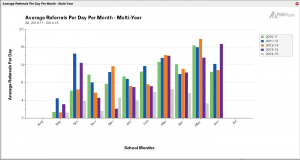Monthly Archives: October 2015
New Programs in the Fern Ridge School District:
Restorative Practices & the Amazing Results So Far
Restorative Justice in schools “is defined not in terms of those who are to blame ‘getting their just desserts’ but as ‘all those affected by an “offence” or incident being involved in finding a mutually acceptable way forward.” [Hopkins, 144]
Here are a few of the principles of the Restorative Justice process….
There must be voluntary participation, and everyone must show respect for those involved. Anyone impacted by the event must be included. The focus will be on the harms, needs, and or causes that have come about by this action, and the consensus-based process for making decisions is focused on how to repair that harm and prevent future harm in the process. There is an opportunity for conversation within the group which truly expands the ability of the community involved to create a just and fair response to the event.
The intention is to move away from ‘punishment’ and move toward restoring a feeling of well-being for the folks involved. It allows for accountability yet breaks the cycle of retribution or violence. Severed relationships can be mended, and individuals who are involved can be empowered. When a small group or an individual does something to one person, it affects that person, the community and the people in the group as well.
An example might be helpful. Let’s say that a small group of middle school students pick on a new student on the playground. It is not only the single child that is hurt- their parents and the middle school community is also hurt. As a result of feelings that develop surrounding that treatment, other parents may be afraid to let their child go to that school or go outside during free time. This then affects the entire community. But the question remains- how does all this actually hurt the students doing the bullying? When the groups have sat down and communicated with facilitation from school leaders, issues have surfaced that were not seen or even thought of. Let’s say the bullied child is quiet and shy. Perhaps one of the group extended a comment or a gesture that was seemingly ignored thus hurting that person who shared it with his/her group and started the aggression. This is certainly possible with adults so am sure it is possible with our children as well. Within the circles of discussion, this would come out- The bullied child would understand better how his or her behavior can be misinterpreted; the action group learns the truth about that reaction and the community, both school and area, breathe easier.
So the new program at the middle school is building School-Wide Prevention Practices which include: identifying common values and making guidelines; developing ‘social-emotional’ skills; developing healthy relationships which promote a sense of belonging and ownership. If something occurs, those involved will learn how to manage these issues while preventing harm and solving any differences that occur. Then there is the accountability piece. No one is getting away with anything, and there will still be consequences, but not so much in the form of suspensions as in the past. The majority of students and community members will be served by this process. Of course, there may be a few, in any population, who require a more intense intervention but the focus will still be on rebuilding relationships and focusing on accountability. Dr. Storm pointed out one of the major reasons for this approach is that “we are trying to reduce our “’exclusionary practices’ and find more creative ways of holding students accountable so they don’t miss instruction.” [emphasis is mine]
Finally, the results are pretty amazing. Dr. Storm also says that “The results speak for themselves so far, and we have only just begun. The referrals from the year 2012-2013, compared to 2014-2015, are clear. We are having half the referrals that we had just last year, and the program is new and just beginning to firm up. To be more precise, in 2012-2013, out-of-school suspensions occurred for 74.5 days for 59 events with 36 students involved while in 2014-2015, there were only 31 days of suspension for 16 events and only 14 students involved. Now that is pretty overwhelming statistics.” [See following graph- thank you Principal Barsotti]
For more information and ideas of questions that would be asked in a situation such as I suggested as an example check out my major sources listed below. Personally, I think there is a great deal to be learned as an adult or as countries in these actions so that we might learn to play well with others as well.
Works used:
Hopkins, Belinda. “Restorative Justice in Schools.” Support for Learning, 17:3, [2002]
Kidde, Jon & Alfred, Rita. Restorative Justice: A working guide for our schools. 2011. San Leandro, CA: Alameda County School Health Services Coalition.
Morton, Twinkle. “Restorative Justice.” Fern Ridge Review. Early June 2015. Now on school district’s website: http://www.fernridge.k12.or.us/tmorton/ , last article on page 1.
Restorative Information in graph form… Average referrals per month [months across the bottom with number of referrals on the left axis…. colors represent different years beginning with 2010-11 and ending with 2014-15. Sorry tried to make it larger for easier reading- Click on it to make it larger!
